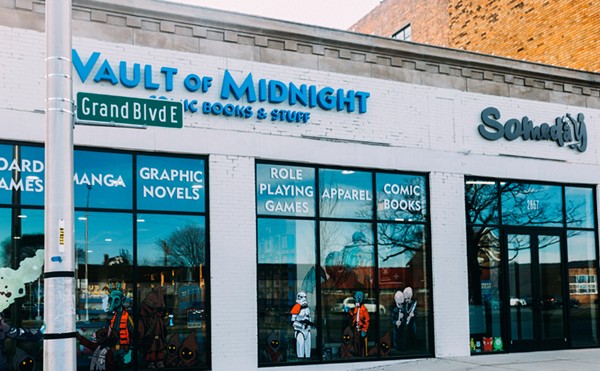You can't miss it. At the junction of I-94 and I-75, the hulking white structure looms mysteriously over the landscape, catching the eye of drivers streaming in and out of downtown. With clean lines, broken only by shattered panes of glass, Fisher Body 21, a former GM-owned factory, stands out. Who worked there? What's going on inside there now? And what will happen to it?
In the hotbed: Milwaukee Junction
Today, this area known as Milwaukee Junction is quiet, but in the early 20th century, it was thriving. Major railroad lines connected its bustling factories to the outside world. Churches, diners, bars and small warehouses were nestled between factories. At the start of the auto industry, the neighborhood was "the Silicon Valley of its day," says Francis Grunow, former executive director of Preservation Wayne. Detroit was a place for crazy ideas: that each person in America could and would own a car; that cars could be made from metal instead of wood; that cars, once hand-crafted, could be mass-produced.
With the advent of the assembly line, the old dark, cramped, narrow factory buildings weren't going to work. To meet the need for buildings that could hold long lines of heavy machinery, architect Albert Kahn developed a new factory, designed for the first time with reinforced concrete. By using interlaced steel rods covered with concrete — which combined the compression strength of concrete and the tensile strength of steel — he created open spaces with lots of natural light. "Kahn became an innovator in factory projects because he pushed the envelope," says Mark Nickita, president of the American Institute of Architects Detroit chapter and of Archive D.S. in Detroit. Once this design was perfected, huge factories went up around the country.
Fisher Body 21 was one such factory. Built in 1919, the Fisher Body Company used it to construct Cadillac and Buick bodies during the 1920s. During the Depression, it suspended production to house a soup kitchen and homeless shelter. Through World War II, the factory was taken over to make P-80 Lockheed Shooting Star Planes, F9-4 Corsair Shipboard Fighters and assemblies for B-25 Mitchell bombers for the U.S. Army Air Corps. From the 1950s through the early '80s, the plant produced limousines, ambulances and 12-passenger buses. Every summer, the workers stopped making limos and learned how to assemble the new models that would be built at plants around the country. Engineers observed the workers' performance, writing notes on which glitches to adjust, which kinks to smooth out.
The last day
By 1981, Fisher Body 21 was becoming obsolete; the building couldn't support the new machinery, the work dropped, and on a warm day in November of 1982, GM officials announced they were going to close the factory.
Two years passed before the factory actually shut its doors. On April 1, 1984, Carl Pearson, plant manager of Fisher Body 21, arrived at work, chatted with his secretary, cleaned his office that overlooked the expressways, and made the rounds, surveying the factory floor he'd supervised since the late 1970s. The lines had stopped. The plant was quiet. Many of the 1,000-some employees he'd supervised had already transferred to the tech design center, taken early retirement or started in a university training program. Pearson, who had seen hundreds of limousine bodies come through the lines at Fisher Body 21 — black or dark blue limos interrupted occasionally by a Mary Kay Pink limo ordered for the cosmetic firm's president — now headed off to the Fleetwood plant for a few years before retirement.
Pearson, now 82, had once been proud of Fisher Body 21. Driving past he would smile to see the gleaming carriage logo painted on the water tower, and the American flag flapping in the wind on the southwest corner of the building. "That was a well-run factory," he remembers. Now, driving by brings back pangs of nostalgia and frustration that such a great building was allowed to deteriorate. "I'm disappointed to see what it looks like now," he says.
After GM left, Fisher Body 21 was utilized by paint companies until it was closed for good in 1993. For a while, homeless people took shelter in the factory, but they've since moved on and the building is now used by scrappers, urban explorers and artists. For years, a homeless man nicknamed "Country Boy" lived in the southeast corner of the building, collecting scrap metal into a shopping cart and hauling it to the nearest yard. But, as that industry has grown and scrappers have gone from removing valuable copper to nickel, brass, steel and finally the least valuable — iron ore — professional scrappers in pickup trucks have taken over. There's little of value left, yet scrappers still drive up in their pick-up trucks, hunting around for the last remaining bits, hauling it off for 8 cents a pound, $185 for a ton.
The scrappers share the space with artists and adventurers. Robert Klatt, 36, has explored more than 40 buildings in Michigan, Indiana and Chicago. "In these buildings," he says, "I can get a grasp of what life was like back then, when Detroit was thriving." When Klatt visited Fisher Body 21 in the late 1990s, he was struck by the monolithic mass and "the fact that you could be so singular in a space that's designed to accommodate so much bulk."
The artists find that each floor has its own character and surprises. On the third floor, boxes of yellow dye bottles are stacked against one wall. "As Seen on TV" mouse-trap packaging covers the floor like a rug. Small signs and stickers from a long-past human resource campaign alerting us to "Quality Fever: Catch It" litter the building. A rusted sign alerts visitors that 150 pounds per foot is the maximum floor load.
In the 11 years that local artist Scott Hocking has lived a few blocks away from Fisher Body 21, he's developed a connection with it, salvaging objects and using the building for photography and as a site for installation art. His latest installation incorporates wooden bricks that make up the floor. "I wanted to use objects that were here already and that were in abundance," he explains. Hocking chose the third floor because the bricks had been loosened, pushed up by years of freezing and thawing, and because of the blue glass that tints the interior light. Working in a usually quiet factory, he stacks the wooden bricks on top of one another creating a large pyramid that's bathed in blue-tinted light. "Pyramids have a mystical quality, and an unknown connection with our unconscious," he says. Since he finished "Ziggurat" this spring the ice has melted and the sculpture has settled, making it look "like a real ruin."
Hocking knows that both his piece and the environment change over time. Another artist once collected all the round-flat washers in the building and stored them in a small room, but now only a scattering of washers remains. While Hocking was constructing "Ziggurat," a row of cacti appeared on a windowsill, but didn't make it through the winter. The blocks of "Ziggurat" have moved slightly, he surmises, from when someone climbed on top of the pyramid to have their picture taken. But even the scrappers are respectful of the piece, working around it as they tear the building apart with gas-powered saws. Hocking's documentary portraits of "Ziggurat" and the Fisher Body plant will travel in October to the Netherlands for an exhibition called Heartland at the Vanabbe Museum in Eindhoven.
Of course, graffiti is scrawled throughout the Fisher factory. At the top of the southeast stairwell, on a large metal shaft overlooking the east side of the I-75 and I-94 junction, one aficionado who's upset with tags that have covered over work by "Beta," an artist that he liked, scrawled: "There used to be a Huge Beta up here underneath all the crap to your left. I grew up looking at that spot. It's disappointing to see it now thanks to a lot of emo art fags. Learn some respect! Signed Otis Fbsk."
Across from Otis' rant, someone wrote "Ebola" in huge black and white block letters trailing a spider web motif. And near a line drawing of Homer Simpson, "Bringing Beef Like" is scrawled in faded black. Above it all, the water tower looms, now painted a sickly pink.
What's in store
For the time being, Fisher Body 21 appears to be in flux. There are speculations that a developer is interested in buying the factory to convert it into a storage facility. The building is owned by the city of Detroit, added to the rolls by foreclosure. Fisher Body 21 was not on the list of 50 abandoned buildings to be torn down around Detroit, so the question of what to do with it remains. In general, abandoned factories are an economic, health and community hazard, says Margaret Dewar, Ph.D., a University of Michigan professor of urban and regional planning. "They are really hard on people that live nearby."
When it comes to redevelopment, Detroit's old factories can't all become art centers, offices or condos. "You have to have a reasonable reuse" for these factories, says Jeff Horner, lecturer with the urban studies program at Wayne State. "There aren't enough new industries coming in to replace the old." Reinforced concrete factories take money and energy to tear down, but most immediately, the building is dangerous: PCBs were found in the soil in a trench on the first floor, and in the woodblock flooring, lead and arsenic levels are high. Drums and containers are still full of solid and liquid waste and asbestos covers the floor in the debris. In 2007, the Michigan DEQ requested that the federal Environmental Protection Agency clean the site, which presents "an imminent and substantial endangerment to both the public health and to the environment."
One thing Fisher Body 21 does have going for it is its size and location. It's on a major corridor and already near to homes and businesses, so it could be relatively easy to incorporate back into the neighborhood. It may be expensive, says Grunow, but "that's not to say that there shouldn't be efforts made ... to give these sites the opportunity to have a second chance."
Samantha Cleaver is a freelance writer for Metro Times. Send comments to [email protected]




